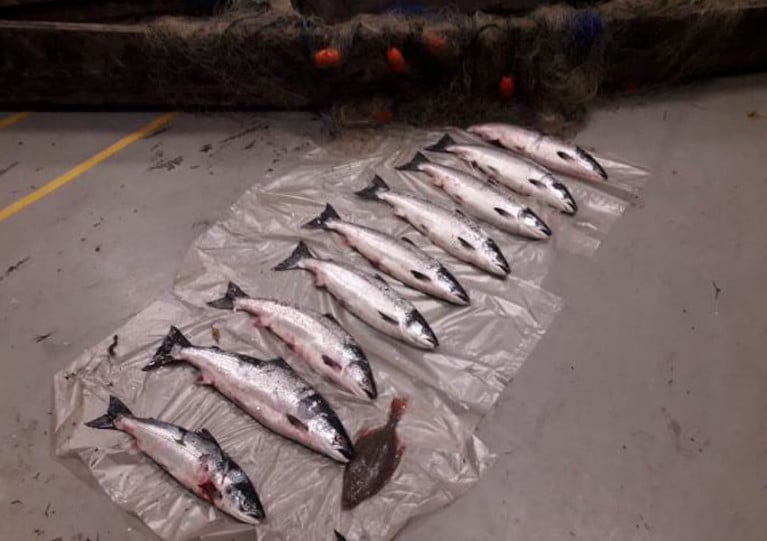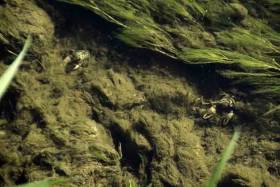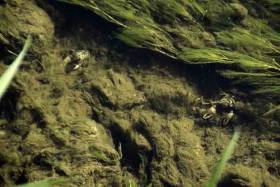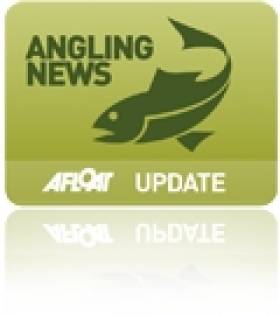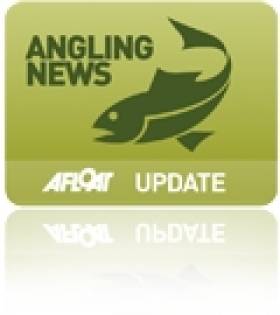Displaying items by tag: River Suir
Inland Fisheries Ireland (IFI) has secured a prosecution against Uisce Éireann (formerly Irish Water) after 40,000 litres of chemical leaked into a stream, killing 100 fish.
The incident happened on 11 June 2022 at the Whelan’s Bridge Stream, a tributary of the River Suir in Co Waterford, and caused the death of 100 fish including salmon, trout, lamprey and eels.
Uisce Éireann was found to have committed water pollution breaches at the Adamstown Water Treatment Plant at Kilmeadan, Co Waterford and must now pay more than €7,100 in connection with the incident.
Evidence was given by IFI Fisheries Environmental Officer Oliver McGrath who outlined the facts to the court.
Approximately 40,000 litres of aluminium sulphate — a chemical toxic to fish and aquatic invertebrates — discharged into the stream from storage tanks on the plant site.
The defendants were found to have permitted or caused deleterious matter to enter into the waters of the Whelan’s Bridge Stream, contrary to Section 171 of the Fisheries (Consolidation) Act 1959.
Waterford District Court imposed a fine of €4,000 on Uisce Éireann, and it was also ordered to pay costs of €3114.60, when the case was finalised last week on Monday 26 February.
Commenting after the verdict, Lynda Connor, South Eastern River Basin District director at IFI said: “This outcome highlights IFI’s continued and determined efforts to protect and conserve Ireland's inland fisheries resource.
“Fish kills, such as these, are serious and damaging ecological events. It is critical that Uisce Éireann ensures that adequate systems and processes are in place to prevent any such incident recurring.”
A separate IFI investigation resulted in Uisce Éireann being fined €10,000 in relation to the death of 2,000 fish in Co Clare in May 2023, as previously reported on Afloat.ie.
Sturgeon Discovered in River Suir in Clonmel This Month
A distressed sturgeon was discovered in shallow water near Sir Thomas’s Bridge in the River Suir, near Clonmel in Co Tipperary on Thursday 1 June.
Inland Fisheries Ireland (IFI) says it was a likely escapee reared sturgeon of unknown origin. It weighed 22kg and was 147.5cm long.
Huge, but unsuccessful, efforts were made to revive the fish when discovered by a concerned and vigilant angler, who had immediately contacted IFI staff.
IFI authorised removal of the fish from the river. The sturgeon specimen is to be forensically examined by IFI research staff.
Wild sturgeon (Acipenser sturio) are a protected species under the EU Habitats Directive. Such fish are extremely rare visitors to Irish waters in modern times.
Anglers are being asked to notify IFI if any unusual fish species are observed.
NGOs have called for the restoration of wild sturgeon in Irish waters, as recently reported on Afloat.ie.
Firearm Discharged In Seizure Of Illegal Salmon Net On River Suir
A firearm was discharged by alleged offenders as fisheries officers responded to reports of an illegal net on the upper tidal River Suir late last month.
Nobody was injured in the incident as Inland Fisheries Ireland officers seized a boat, net and nine wild salmon near Carrick-on-Suir during a routine patrol on the night of Tuesday 28 July.
Gardai attended the scene and the matter is being investigated, the fisheries body adds.
IFI director David McInerney said: “The salmon caught by this illegal net were on the final leg of an arduous journey to reach their native spawning rivers.
“The fish were fresh in from the sea, having survived a journey from either the coastal waters off west Greenland or the Faroe Island, before being cruelly killed by an illegal net, a few miles from their final destination.
“It cannot be stressed enough that nobody should purchase wild salmon that does not carry either a green or white gill tag through the mouth and gill clearly displaying the name Inland Fisheries Ireland.
“I would like to highlight the dedication and courage demonstrated by the officers in tackling illegal fishing in the face of significant personal danger.”
#MarineWildlife - In response to a recent outbreak of crayfish plague in the River Suir and River Deel, emergency disease containment measures are needed to help prevent its spread.
Crayfish plague is a disease that kills Ireland’s native white-clawed crayfish. All crayfish that become infected will die.
The disease is easily transmitted in water or via contaminated equipment (for example on canoes, waders or nets).
Ireland holds the largest population of the white-clawed crayfish that remains in Europe.
To help protect our native crayfish from this disease, all water users are asked to operate a temporary ban on moving watersports and angling equipment out of the River Suir and River Deel catchments, commencing immediately.
Watersports and angling equipment currently in use in the Suir and Deel catchments may continue to be used there, but boats or equipment should not be transferred out of the catchment.
Limit your activity to the river section where you normally operate, avoid moving around the catchment and follow biosecurity protocols: Inspect, Remove, Clean, Dispose, Notify.
The Inland Fisheries Ireland website has more information for anglers, boaters, paddle sports enthusiasts and SCUBA divers.
All water users are being urged to take precautions after confirmation of an outbreak of Crayfish Plague on a stretch of the River Suir downstream of Clonmel to Carrick-on-Suir. It comes after large numbers of dead freshwater crayfish were reported on the river earlier this month. DNA analysis has now confirmed that the cause of death was crayfish plague.
The kill has only impacted White-clawed Crayfish and other freshwater animals are not affected. This is a characteristic feature of the disease which only infects species of crayfish but causes 100% mortality. All agencies including the National Parks and Wildlife Service, Inland Fisheries Ireland and Tipperary County Council will be working to contain the outbreak to this stretch of the River Suir. Given the experience of outbreaks elsewhere, a total kill of the population is expected which will have major consequences for the ecology of the river. Crayfish are very common in the Suir and are important in maintaining its ecology.
Anyone using the river is being urged to observe the ‘Check, Clean and Dry’ protocol once they leave the river and before using it again. This means that all wet gear (boats, clothing and equipment) should be checked for any silt or mud, plant material or animals before being cleaned and finally dried. Disinfectant or hot water (over 40 degrees Celsius) should be used to clean all equipment and this should be followed by a 24 hour drying period.
The drying period is especially important in ensuring that all equipment is clear of infectious organism, including the removal of any water inside the boat. The crayfish plague organism can be carried on wet equipment to new sites and containment of the outbreak is essential to prevent spread to other unaffected populations in Ireland.
This is the second confirmed outbreak of the disease in Ireland following one in County Cavan in 2015. There is no indication of how the disease reached the Suir although a link to the Cavan outbreak is considered unlikely as the disease there appears to have run its course. This outbreak on the River Suir is of great concern as the stretch of river affected is popular with anglers and canoeists.
The White-clawed Crayfish is a globally threatened species and Ireland holds one of the largest surviving population. It is the only freshwater crayfish species found in Ireland and is present in lakes, rivers and streams over much of the island. Throughout its European range, this species has been decimated by the impact of Crayfish Plague which spread to Europe with the introduction of North American species of crayfish. Until 2015, Ireland was considered free of the disease and it remains the only European country without any established non-native crayfish species.
If Crayfish Plague becomes established there is a high probability that the White-clawed Crayfish, which is currently protected under Irish Law and the EU Habitats Directive, will be eliminated from much of Ireland. If non-native crayfish are found to be established in Ireland, this could have a severe impact on habitats as they can destabilise canal and river banks by burrowing. It could also impact other freshwater species, such as salmon and trout fisheries. At this time however, there is no evidence that non-native freshwater crayfish have been introduced in this country.
The public are asked to follow the ‘Check, Clean and Dry’ protocol when using the river and to alert the authorities of any mass mortality of crayfish as well as sightings of unusual crayfish (e.g. red claws, large size). by emailing Colette O’Flynn ([email protected]) at the National Biodiversity Data Centre, Waterford.
Passage East Ferry Company Is Up For Sale
#FerryNews - A popular ferry service between Waterford and Wexford is up for sale, as The Irish Times reports.
The Passage East Ferry Company, which runs car ferry services across the River Suir between Passage East and Ballyhack, is putting itself on the market due to the pending retirement of its founder and operator Derek Donnelly.
In continuous operation since 1982, the company – which employs 16 people full time and has turned over around €1.6 million per year over the last five years – experienced a 5.4% rise in passenger numbers in 2015.
Accountants Crowe Horwath expect the sale "will generate significant interest, not in the domestic and international markets". The Irish Times has more on the story HERE.
New Salmon & Sea Trout Bylaw for River Suir
#Angling - Recreational angling on the River Suir is set for a change as a new bylaw sought by a majority of anglers has been signed into law.
As of Friday 12 April till the end of the season, when fishing for salmon and sea trout (over 40cm) on the River Suir, the use of worms, prawn, shrimp or any other crustacean or artificial forms thereof as bait is prohibited - as is the use of any fish hooks other than single barbless hooks, up to and including 11 May.
From 12 May to 30 September the bylaw provides for a bag limit of five fish for the season subject to a daily bag limit of one fish. Anglers must use a single barbless hook once their daily or season bag limit has been reached.
Inland Fisheries Ireland (IFI) points out that this bylaw is applicable to the 2013 season only.
It is hoped that this measure will ensure even better angling for the many local anglers and angling tourists that come to fish the Suir for brown trout from Tipperary to Waterford.
New Angling Guides and Salmon Bait Restrictions
#Angling - Inland Fisheries Ireland has recently added two new guides to its list of resources for anglers fishing in Ireland.
The West of Ireland Sea Angling Guide covers the region from Westport, in Clew Bay, south to the rocky headlands of North Clare, including Galway Bay, Connemara, Killary, Louisburgh, Clew Bay, and the offshore islands of Inisbofin, Inisturk and the Aran Islands.
The guide is in no way comprehensive, and the list of marks and venues is just a sample of what is available across the region's waterways. There are literally hundreds of shore marks in the region that have rarely, if ever, been fished, but the potential waiting to be explored is immense. Getting off the beaten path and trying a new mark may produce the fish of a lifetime.
In addition, the County Sligo Game Angling Guide covers the main game angling waters in the district. It contains information on the location of each fishery as well as details in relation to contacts, permitted angling methods, angling seasons, etc.
Meanwhile, IFI has received numerous submissions from individual anglers, angling organisations and angling tourist providers regarding restrictions on the use of prawn/shrimp as a salmon angling bait on the River Suir for the 2013 season.
IFI is interested to hear the views of other angling stakeholders or from those who wish to make further submissions.
Submissions can be made to IFI Clonmel by email at [email protected] or by post to Inland Fisheries Ireland, Anglesea Street, Clonmel, Co Tipperary.
The closing date for receipt of submissions is 28 February 2013.
#CRUISELINERS – The Quest (1992/1,180grt) an ice-strengthened expedition cruiseship, will have the distinction of being the first cruise caller to Dun Laoghaire Harbour in many years. The cruise call next week (24th April) will mark a new era in attracting the cruise sector as part of the harbour's masterplan launched last year, writes Jehan Ashmore.
The Quest will have a German clientele of around 50 passengers, though other larger capacity vessels are scheduled for the summer in this first phase of cruise callers. The cruise sector season is seen to be a significant economic boost to the local economy considering the reduced ferry side of the harbour business in recent years.
Passengers on the Noble Caledonia operated vessel are to take a 9-night 'Garden' Cruise with prices starting from £3,295. She is to set sail from Oban Scotland, then to Ireland, Wales, Cornwall, the Isles of Scilly and Channel Islands.
On her Dun Laoghaire call passengers will head for Powerscourt and nearby Mount Usher gardens in Co. Wicklow. On the second Irish port of call to Waterford as previously reported, they will visit the privately owned Mount Congreve Gardens on the banks of the River Suir.
Notably scheduled in for next year's season is the 'flagship' of the Cunard Line fleet, the 2,620 passenger liner Queen Mary 2, all of 151,400 gross tonnes. She is to make an anchorage call in May 2013, according to Captain Frank Allan, Dun Laoghaire Harbourmaster.
As part of the programme to attract and develop Dun Laoghaire as a cruise call port of call, a new tender docking facility was recently completed. The facility is designed to cater for large cruiseships using the harbour as it will cater for easier access by boats tendering passengers to vessels such as Queen Mary 2 during anchorage calls out in Dublin Bay.
The new tender facility will also benefit the public as the facility can be used for training purposes and for the operation of boat tours around Dublin Bay and trips out to Dalkey Island.
- Dun Laoghaire Harbour
- Cruise Liners
- Irish cruise calls
- Noble Caledonia
- MVQuest
- Cunard Line
- Queen Mary 2
- QM2
- Dun Laoghaire Harbour Company
- Dublin Bay
- Dublin Bay anchorage cruise calls
- Dalkey Island
- Powerscourt Gardens
- Mount Congreve Gardens Waterford
- River Suir
- Dun Laoghaire Harbour Masterplan
- Dublin Bay News
Draft Net Season Won't Be Brought Forward Says Minister
#ANGLING - Minister for Natural Resources Fergus O’Dowd has confirmed that there is no proposal for the extension of the salmon draft netting season.
In response to concerns expressed by the angling community and highlighted by Derek Evans in The Irish Times last week, Minister O’Dowd emphasised that conservation and management of salmon and sea trout is key to protecting our valuable natural resources.
“Recent reports that the commercial season will be extended in certain rivers are untrue and I can confirm that for the 2012 season, the commercial fishing season remains as it was in all areas, with the River Suir still on a reduced season for snap fishing," said the minister.
"I am aware that confusion can arise due to the necessary extent of regulations in place. However, I am not considering any proposal for the extension of the commercial season."
The minister reminded that Inland Fisheries Ireland is the body that enforces Ireland's "extensive" fisheries legislation.
"IFI has offices throughout the country where advice can be sought. There is also a comprehensive and regularly updated website and information is also disseminated on Facebook and Twitter," he said.
Meanwhile, IFI chief executive Dr Ciaran Byrne said that the legislative code is regularly updated to ensure that Ireland's fisheries continue to be protected on the basis of information from IFI’s Standing Scientific Committee and IFI management advice.
“Only rivers with exploitable surpluses are open during the spring season and no fishery is open for commercial exploitation during this time," said Dr Byrne. "Fisheries that are classified catch-and-release or closed for salmon are now protected under bye-law 897 which prohibits the use of worms and the use of any fish hooks other than single barbless hooks.
"IFI’s priorities are maximising the return to Ireland, protecting sustainable jobs in isolated rural communities and promoting our wonderful angling resources," he added.


























